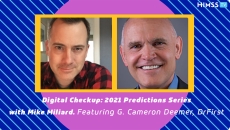Patient Engagement
Called FIRE Wire, the solution will allow physicians and their teams to share messages, referrals and patient data with community-based organizations.
Cameron Deemer, president of DrFirst, explains how practical machine learning applications can help improve safety and efficiency - automating medication history in hospital EHRs and aggregating patient records in consumer apps.
There's a desire for greater personalization, with 86% of members wanting their plan to personalize communication, care and services.
President Biden says the U.S. will soon be vaccinating 1.5 million people a day.
Understanding the reasons that patients forgo care is an important component in designing policy and clinical interventions.
Ninety-five percent of respondents agreed it is important for seniors to have coverage options aside from traditional Medicare.
The program will be implemented in four state community locations, including in Alaska, Michigan, Texas and West Virginia.
This week's top stories include Optum and Change uniting; Amazon, Berkshire Hathaway and JPMorgan Chase's Haven joint venture calling it quits; and patient engagement tools playing a key role in streamlining the COVID-19 vaccine rollout.
SPONSORED
Stanley Chiang, E Ink's director of strategic partnership, discusses how the company's technology frees up nurses while ensuring patient data is accurate and improving the patient experience.
When formed in January 2018, the joint venture was expected to upend the healthcare industry.



